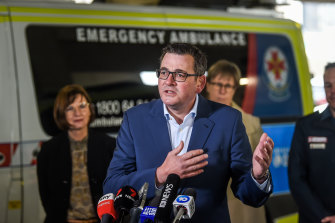Key points
- Australia’s peak medical group will look into whether the isolation period should be cut at the end of September.
- Health experts have backed political leaders’ position to delay cutting the quarantining of COVID-19 patients from seven days to five.
- Premier Daniel Andrews said the middle of winter was not the right time to be making any changes to isolation rules.
Australia’s chief health officers will look into cutting the COVID-19 isolation requirements from seven days to five at the end of September when surging coronavirus cases are expected to subside.
Prime Minister Anthony Albanese and Victorian Premier Daniel Andrews said on Monday that the national cabinet discussed cutting the isolation period from seven days to five, but the medical advice was that “now is certainly not the time” with the country in the midst of a coronavirus wave. There are 64,000 reported active cases in Victoria.
Premier Daniel Andrews said now was not the time to be cutting isolation requirements. Credit:Justin McManus
The Australian Health Protection Principal Committee, whose members include the chief medical officers of every jurisdiction, resolved to postpone their discussion about reducing isolation requirements until the end of September.
The discussion will coincide with the end of pandemic isolation payments, but state and federal government sources have insisted the decisions will not be linked.
The expert medical advisory group met earlier this month and warned of a new wave of infections, driven by the BA.4 and BA.5 Omicron subvariants of COVID-19.
In a statement released after its most recent meeting, the committee said the current wave will lead to a “substantial increase in infections, hospitalisations and, sadly, deaths at a time when our communities and health systems are already under strain”.
The debate over isolation requirements was triggered by NSW Premier Dominic Perrottet’s suggestion that quarantine requirements for COVID-19 positive patients should eventually be reduced, though not during the current winter surge in cases.
Andrews said while he backed his NSW counterpart’s comments, altering the rules right now would make it “harder and harder” for healthcare workers who are already under pressure.
“Even [Perrottet’s] own position at national cabinet on Saturday was not that it should occur right now in the middle of winter, but at some point,” Andrews said on Monday.
“We will get to that point at some point in the future where we don’t have to isolate. But in the middle of winter, that’s not the right thing to do right now.”
Former Victorian deputy chief health officer Allen Cheng said it was prudent governments delayed decisions on altering isolation requirements. Credit:Nicole Reed
Australia’s top health experts agreed with the decision to delay any cuts to the isolation period, saying now was not the time to be tweaking rules targeted at COVID-positive people.
One of the country’s top pandemic advisers, Professor James McCaw, said governments across the country needed to continue maintaining policies aimed at slowing the spread of the virus, which federal government modelling has shown will infect millions of Australians over the coming weeks.
“It’s really important at the moment that we have policies and public messaging to encourage people to slow the spread of the virus and to encourage people to make choices that slow the spread of the virus,” McCaw said.
“Like all aspects of COVID management, over the long term, all of these things need to be continually evaluated to ensure they’re achieving the goals for what they were intended.”
Catherine Bennett, Deakin University’s chair in epidemiology, urged the government to release data on the impacts that cutting isolation requirements from seven days to five would have on spreading the virus.
“Maybe it’s about saying, ‘let’s have five days of iso and two days forced mask-wearing and being able to go to work but not socialising’,” Bennett said.
Allen Cheng, a former Victorian deputy chief health officer, said the requirement to isolate for seven days would eventually need to be reduced, but it was prudent to wait.
Isolation periods throughout the pandemic have been reduced from 14 days to 10 and now seven.
Cheng said there were still risks people could be contagious after their isolation period, but they were manageable.
“If you’re otherwise fit and healthy, maybe 10 to 20 per cent of people are infectious on day seven but much less on day 10,” Cheng said. “On day five, slightly more people are infectious than day seven or 10.”
James Trauer, head of Monash University’s epidemiological modelling unit, said while he advocated pulling back on measures designed to reduce transmission to instead focus on protecting people against serious illness and death, there was value in maintaining forced isolation of COVID-positive people.
“We will gradually work our way through to COVID not being as big a deal as it had been,” Trauer said. “But the focus for me is the next couple of months … we have to see the current peak pass and hospitals beginning to get back to normal before we should start thinking about pulling back.”
The Morning Edition newsletter is our guide to the day’s most important and interesting stories, analysis and insights. Sign up here.
Most Viewed in Politics
From our partners
Source: Read Full Article

